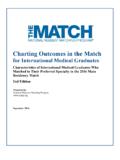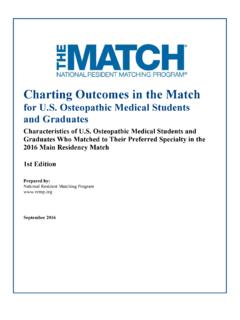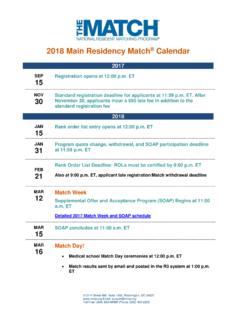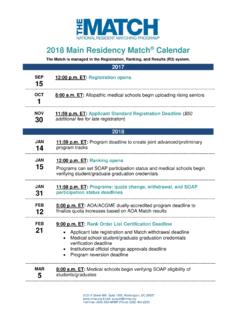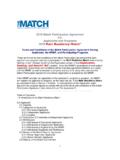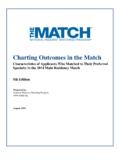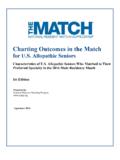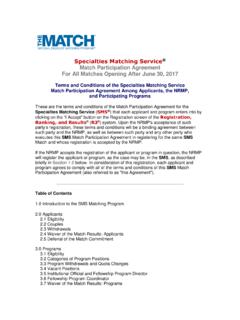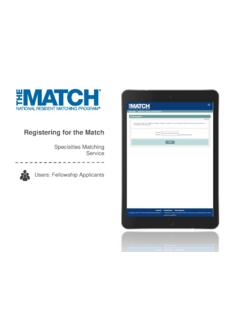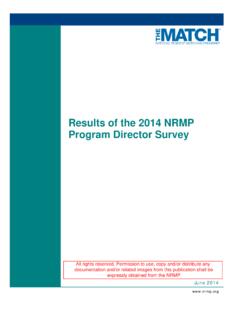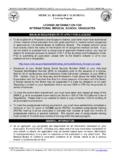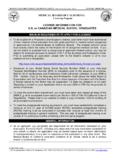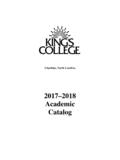Transcription of Charting Outcomes in the Match
1 Charting Outcomes in the MatchInternational medical GraduatesCharacteristics of Applicants Who Matched to Their Preferred Specialty in the 2013 Main Residency Match1st EditionPrepared by:National Resident Matching Programand Educational Commission for Foreign medical GraduatesJanuary about the contents of this publication may be directed to Mei Liang, Director of Research, National Resident Matching Program, (202) 400-2233 or about the NRMP should be directed to Mona M. Signer, Executive Director, National Resident Matching Program, (202) 400-2233 or about the ECFMG data collections may be directed to John R. Boulet, , Vice President, Research and Evaluation, Educational Commission for Foreign medical Graduates,(215) 823-2227 or 2014 National Resident Matching Program and Educational Commission for Foreign medical Graduates. Revised January 9, 2014. All materials subject to this copyright may be photocopied for the purpose of nonprofit, scientific, or educational CitationNational Resident Matching Program and Educational Commission for Foreign medical Graduates.
2 Charting Outcomes in the Match for International medical Graduates, 2014. National Resident Matching Program and Educational Commission for Foreign medical Graduates. 2014 Table of Contents Introduction .. iiTables and Charts for All Specialties Chart 1. Active Applicants in the 2013 Main Residency Match .. 1 Table 1. Number of IMG Applicants and Positions in the 2013 Main Residency Match .. 2 Chart 2. Ratio - IMG Applicants Ranking Specialty First / Available Positions .. 3 Chart 3. Match Rates .. 4 Table 2. Summary Statistics .. 5 Chart 4. Median Number of Contiguous Ranks .. 6 Graph 1. Probability of Matching to Preferred Specialty by Number of Contiguous Ranks .. 7 Chart 5. Mean Number of Different Specialties Ranked .. 8 Chart 6. USMLE Step 1 Scores of Matched Applicants .. 9 Graph 2. Probability of Matching to Preferred Specialty by USMLE Step 1 Score .. 10 Chart 7. Mean Number of USMLE Step 1 Attempts .. 11 Graph 3.
3 Probability of Matching to Preferred Specialty by USMLE Step 1 Attempts .. 12 Chart 8. USMLE Step 2 CK (Clinical Knowledge) Scores of Matched Applicants .. 13 Graph 4. Probability of Matching to Preferred Specialty by USMLE Step 2 CK (Clinical Knowledge) Score .. 14 Chart 9. Mean Number of USMLE Step 2 CK (Clinical Knowledge) Attempts .. 15 Graph 5. Probability of Matching to Preferred Specialty by USMLE Step 2 CK (Clinical Knowledge) Attempts .. 16 Chart 10. Mean Number of Attempts at USMLE Step 2 CS (Clinical Skills) or ECFMG CSA (Clinical Skills Assessment) .. 17 Chart 11. Mean Number of Months after ECFMG Certification .. 18 Chart 12. Mean Number of Years After Graduation .. 19 Chart 13. Percentage of IMG Applicants whose Native Language is English .. 20 Chart 14. IMG Applicants Citizenship at Birth .. 21 Chart 15. Country of medical School.
4 22 Tables and Charts for Individual Specialties Anesthesiology .. 24 Emergency Medicine .. 40 Family Medicine .. 56 Internal 72 Neurology .. 88 Obstetrics and Gynecology .. 104 Pathology .. 120 Pediatrics .. 136 Physical Medicine and Rehabilitation .. 152 Psychiatry .. 168 Radiology .. 184 Surgery ..200 Copyright 2014 NRMP and ECFMG. Copies may be made for educational or noncommercial uses Outcomes in the Match for IMGs, 2014iCopyright 2014 NRMP and ECFMG. Copies may be made for educational or noncommercial uses Outcomes in the Match , IMG, 2014 OverviewCharting Outcomes in the Match for IMGs is a collaborative publication of the National Resident Matching Program (NRMP ) and the Educational Commission for Foreign medical Graduates (ECFMG ). The report focuses on characteristics specific to students and graduates of international medical schools (IMGs) and is derived from the original Charting Outcomes in the Match , a biennial report published by the NRMP and the Association of American medical Colleges that describes the characteristics of allopathic senior students and independent applicants* who matched to their preferred specialties in the Main Residency Match .
5 ECFMG and its organizational members define an international medical graduate (IMG) as a physician who received his/her basic medical degree or qualification from a medical school located outside the United States and Canada. The location of the medical school, not the citizenship of the physician, determines whether the graduate is an IMG. Thus, citizens who graduate from medical schools outside the United States and Canada are considered IMGs. citizens who graduate from medical schools in the United States and Canada are not considered CertificationInternational medical graduates must be certified by ECFMG prior to entering accredited residency programs in the United States. Since 2004, to obtain an ECFMG certificate a candidate must (1) document the completion of all requirements for, and receipt of, the final medical diploma, and (2) pass the United States medical Licensing Examination (USMLE) Step 1 (Basic Science), Step 2 CK (Clinical Knowledge), and Step 2 CS (Clinical Skills).
6 Historically, to achieve ECFMG certification, other examination requirements were in effect. Detailed information on ECFMG certification requirements can be found at: Step 1 (Basic Science) assesses whether the candidate can understand and can apply important concepts of the sciences basic to the practice of medicine, with special emphasis on principles and mechanisms underlying health, disease, and modes of therapy. USMLE Step 2 CK (Clinical Knowledge) assesses whether the candidate can apply medical knowledge, skills, and understanding of clinical science essential for the provision of patient care under supervision and includes emphasis on health promotion and disease prevention. USMLE Step 2 CS (Clinical Skills) uses standardized patients to test medical students and graduates on their ability to gather information from patients, perform physical examinations, and communicate their findings to patients and colleagues. Detailed information on the USMLE can be found at: Clinical Skills Assessment (CSA)In July of 1998, ECFMG introduced the Clinical Skills Assessment (CSA ), a performance test designed to evaluate the clinical skills ( , history taking, physical examination, interpersonal skills) of IMGs.
7 The specific purpose of the CSA was to ensure that international medical graduates (IMGs) could demonstrate clinical skills at a level comparable to that of graduating fourth-year medical students. In 2004, the USMLE introduced Step 2 CS (clinical skills), a similar performance-based examination for medical students and graduates. At this point, the CSA was discontinued and all IMGs were required to take and pass Step 2 CS to achieve certification. Charting Outcomes for IMGsCharting Outcomes in the Match for IMGs utilizes a different set of measures from the original Charting Outcomes in the Match . Although some applicant characteristics such as number of contiguous ranks, number of specialties ranked, and USMLE scores are included in both reports, other characteristics relevant only to IMGs are added to this report: certification examination attempts, number of months since ECFMG certification, English spoken as a native language, citizenship at birth, country of medical school, and number of years since graduation from medical *Independent applicants include previous graduates of medical schools, students and graduates of osteopathic medical schools, citizen IMGs, citizen IMGs, students and graduates of Canadian medical schools, and graduates of Fifth Pathway programs The Educational Commission for Foreign medical Graduates (2000).
8 A History: 1956-2000. Educational Commission for Foreign medical Graduates, Philadelphia, PAIntroduction (Continued)iiiCharting Outcomes in the Match , IMG, 2014 Copyright 2014 NRMP and ECFMG. Copies may be made for educational or noncommercial uses from the 2013 Main Residency Match , including applicant type, specialties ranked, number of contiguous ranks, and Match results, were obtained from the NRMP Data Warehouse. ECFMG provided characteristics of the 2013 IMG applicants, namely scores and attempts at USMLE or equivalent historical examinations ( , Step 1 or equivalent, Step 2 CK or equivalent, and Step 2 CS/ or ECFMG CSA), date of ECFMG certification, year of graduation, English spoken as a native language, and country of medical school. Data from the two sources were matched using unique measures are incorporated in the report for specialty-specific analysis. Each measure is explained separately in the All Specialties section. Twelve specialties with 100 or more IMG applicants in the 2013 Main Residency Match are studied individually: Anesthesiology, Emergency Medicine, Family Medicine, Internal Medicine, Neurology, Obstetrics and Gynecology, Pathology, Pediatrics, Physical Medicine and Rehabilitation, Psychiatry, Radiology, and General purposes of this report, Match success is defined as a Match to the specialty of the applicant s first-ranked program because that is assumed to be the specialty of choice.
9 Because preliminary programs provide only one or two years of prerequisite training for entry into advanced specialty training, applicants who ranked a preliminary program first are considered not to have a preferred specialty. Lack of Match success includes matching to another specialty as well as failure to Match at all. No distinction was made based on whether applicants matched to their first, second, third, or lower program choice. Applicants who obtained positions in the Match Week Supplemental Offer and Acceptance Program (SOAP ) were not included in the analysis is performed on the number of contiguous ranks, Step 1 scores and Step 1 (or equivalent examination) attempts, Step 2 CK scores and Step 2 CK (or equivalent examination) attempts, and combined Step 2 CS/ECFMG CSA attempts. For each of those measures, probability of matching to a preferred specialty is calculated separately using logistic general observations apply to all of the specialties in this report. IMG applicants who are successful in matching to their preferred specialty are more likely to: rank more programs within their preferred specialty have higher USMLE scores have fewer attempts at ECFMG certification examinations be citizens speak English as a native language have obtained ECFMG certification closer to the Match year (2013) have graduated from medical school closer to the Match year (2013)Although some other measures appear to be related to Match success, the relationships were not consistent enough to draw broad conclusions across specialties.
10 In addition, the data sources used for this report do not include other important applicant factors such as course evaluations, reference letters, and the medical Student Performance Evaluation. Despite the fairly strong relationship between USMLE Step scores and Match success, the distributions of scores show that program directors consider other qualifications, and high USMLE scores are not a guarantee of success. Even in the most competitive specialties, a few individuals with higher scores are not successful. Neither is a lower score a bar to success. Program directors and applicants will find the tables and charts for the specialties of their particular interest later in this questions, comments or more information, please contact: Mei Liang, Director of ResearchJohn R. Boulet, Vice President, Research and EvaluationNational Resident Matching ProgramEducational Commission for Foreign medical GraduatesTel: (202) 400-2233 Tel: (215) 823-2227 Email: and Charts for All Specialties7, IMG5, IMG2,677 Osteopathic1, graduate21 Canadian20 Fifth Pathway17, IMG graduate Pathway : NRMP Data WarehouseChart1 Active Applicants in the 2013 Main Residency Matchby Applicant TypeCopyright 2014 NRMP and ECFMG.
